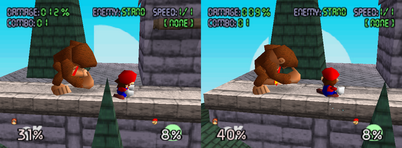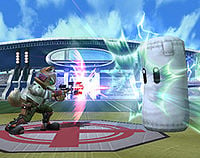Stale-move negation

Stale-move negation (ワンパターン相殺, One-pattern offsetting), also known as Repetition Effect in Super Smash Bros. 4, is a gameplay element in all games in the Super Smash Bros. series. It refers to how moves cause less damage and knockback as they are used multiple times in a row. The strength of a move increases back to its regular power as other moves are used. Starting in Melee, being KO'd resets the staleness of all of that player's moves. Moves not yet affected by stale-move negation are referred to as fresh. Moves are only affected by stale-move negation if they connect with an opponent or other object that can take damage.
The purpose of stale-move negation is to discourage players from using the same attack repeatedly or over-frequently, and encouraging the utilization of a character's entire moveset.
Stale-move negation is applied to the whole attack rather than individual hitboxes. As such, landing the weak hitbox will weaken all hitboxes in the attack just as landing the strongest hitbox would. Moves that are counter-attacks or absorbers do not take the stale-move negation of the incoming attack into consideration. Items are also affected by stale-move negation, even if the player drops the item they're holding and picks up a different one of the same. Any variation of the same special move counts as the same move; for example, a Giant Punch shares the same staleness regardless of its charge level, or whether it's used on the ground or in the air.
Calculation
SSB
When a move connects in the original SSB, it is then considered stale. Any consecutive uses of the move will deal 0.75x damage; using the move more than twice in a row does not incur an additional penalty. Hitting with other moves will increase the power of the move over a sequence of three intermediate stages between "stale" and "fresh" before reaching full power.
As SSB only stores damage as integers, and rounds up damage done by attacks, moves that deal less damage are less affected by stale-move negation, to the point where attacks that deal 3% damage or less are essentially immune. Weaker moves will also essentially reach full power in fewer stages; any attack that deals 24% damage or less will (after rounding up) be dealing full damage one stage before they are considered perfectly fresh.
| Stale | Level 1 | Level 2 | Level 3 | Fresh |
|---|---|---|---|---|
| 0.75x | 0.82x | 0.89x | 0.96x | 1.0x |
Using a single move as 35% or more of one's attacks during a match awards the Cheap Shot bonus, worth -99 points. The bonus is not actually connected to stale-move negation; in fact it is possible (though unlikely) to earn it even by using two other moves in between the repeated move.
Melee onward

Stale-move negation is calculated with a queue of the last nine moves a character has connected with. When a move is used that's in the queue, its damage is decreased an amount based on both how often the move is in the queue and how recently the move has been used - a move used seven moves ago will be slightly weaker than a move used eight moves ago, and a move used two moves ago will be weaker than both combined. If a move is used ten times in a row (that is, the queue is full of only that move), the total reduction will cut the move to 55% of the normal damage.
| Queue position | 1 | 2 | 3 | 4 | 5 | 6 | 7 | 8 | 9 |
|---|---|---|---|---|---|---|---|---|---|
| Reduction factor (Melee) | 0.09 | 0.08 | 0.07 | 0.06 | 0.05 | 0.04 | 0.03 | 0.02 | 0.01 |
| Reduction factor (Brawl) | 0.1 | 0.09 | 0.08 | 0.07 | 0.06 | 0.05 | 0.04 | 0.03 | 0.02 |
| Reduction factor (SSB4) | 0.08 | 0.07594 | 0.06782 | 0.06028 | 0.05274 | 0.04462 | 0.03766 | 0.02954 | 0.022 |
Using a mid-match character change (e.g. Transform or Pokémon Change) will reset the queue.
Melee-specific
Melee has the Stale Moves bonus, worth -2000 points. Like the previous game's Cheap Shot, it is not strictly related to stale-move negation: it is given to players who use one move for 40% or more of all their attacks, unless less than 16 attacks were used in total, or a single-move bonus was earned.
Connecting with a move will immediately affect it; later hitboxes of a multi-hit move will be affected by the new staleness value if earlier hitboxes connect. For example, if the first hit of the Mario Tornado connects, the rest of the hits will be one level more stale. As a result, the finishing hit of multi-hit moves can only connect as fresh if none of the set-up hits connect. As this behaviour does not make much sense, and does not seem to appear in SSB 64, it is believed that it is unintentional.
Strangely, it does not appear that staleness is present when playing from the debug menu.
Brawl-specific
If a move is not in the list of recently-used moves, it earns a freshness bonus of 1.05x damage - therefore, very few attacks ever deal the exact damage they are programmed to do. Stale-move negation is not applied in any one-player modes except for the Home-Run Contest (including Training, which initially confused those trying to test the effect).
Unlike Melee, Brawl protects later hitboxes of multi-hit moves from being staled while the move is in progress. This results in an unusual quirk if an attack's ending lag is interrupted by another instance of the same attack - the move is put into the queue for each time it hits, but the attack doesn't decrease in damage until the character enters a different action. For example, multiple quick hits of Meta Knight or Marth's down tilt will all deal maximum damage if initiated during the cooldown of the previous one, not decreasing in damage until the chain ends and the character enters their crouching or standing state.
Testing has shown that the Ice Climbers share one staleness queue between them, with only the leader's moves having any effect on the queue when they connect. It is currently unclear how exactly this interacts with the staleness protection above, other than Nana's move being guaranteed to have the same staleness level as Popo's under regular non-desynched conditions. It is currently unknown whether Melee also has both characters share a queue.
In SSB4
The mechanic acts how it was in Brawl, but items are no longer subject to stale-move negation, including character-produced items such as Link's Bombs and Mega Man's Metal Blade.
Projectiles
An unusual peculiarity of the stale-moves system is how it applies to projectiles. When a projectile is created, its staleness value is set based on the move's current staleness. This means that, if a second projectile is created before the first hits something, both projectiles will have the same staleness value. For example, firing a Blaster from long range will result in a series of beams onscreen at once, all with the same staleness value - once the first beam deals damage, the next to be fired will deal reduced damage, but the ones that already exist will not. Each shot that connects will count as one spot in the stale move queue. This behaviour exists in all four games.
The staleness of a projectile is attached to its existence as an object; simply changing hitboxes does not "re-update" their staleness. On the other hand, should a projectile self-delete and replace itself with something else (for example, when Thunder Jolt hits the ground the aerial ball is deleted and replaced with the grounded wave), its staleness value will be "re-updated". This behaviour is only confirmed in Brawl but is likely to manifest in the other games.
Controversy
While the damage reduction caused by stale-move negation is about the same in Brawl as in Melee, the calculation of knockback in Melee ignores it (for non-projectiles), while Brawl does not. As the damage of a hitbox is a main component in the knockback formula this results in a much more noticeable drop in the knockback of a stale attack.
The much more severe stale-move negation in Brawl has had a mixed reception among the competitive fanbase. Those who support the severe stale-move negation argue that it adds more strategy and depth to the game, giving importance to "saving finishers" until the opponent is in the KO range, while rewarding those who plan the use of their attacks appropriately, and punishing those who rely on their KO attacks to rack up damage. Detractors argue that it allows some attacks to combo into themselves much more effectively than they should, resulting in them being overly powerful damage rackers at low percents. This has been the primary cause of some hard counter matchups, with the most notorious examples of such attacks being Pikachu's down throw and Sheik's forward tilt.
Some mods of Brawl, with the developers having the sentiment of the detractors, alter stale-move negation; some reduce its powers to varying degrees, while others remove it altogether.
Moves that stale-move negation does not affect
Some classes of attacks are ignored by the stale moves system; they never enter the staleness queue, so they will always deal the same damage (and cannot be used to refresh other attacks).
- Grab airs, including the Hookshot, Clawshot, and Grappling Beam
- Grab releases, such as Donkey Kong's cargo throw
- Taunts
In addition, certain hitboxes appear to be immune to the stale moves system due to being attached to an object, which is attached to another object, which is attached to a character. It is believed the "signal" to alter the damage of such hitboxes is not properly propogated along such object chains. An example of this behaviour is Zero Suit Samus's neutral air.
Recoil damage is not subject to staleness.
Staleness is completely absent in "practice" modes like Training, the Online Practice Stage, and the testing area of Customization. It also does not affect matches that are under the effect of Melee's debug menu.